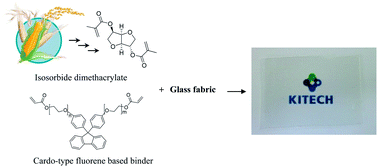A biobased photocurable binder for composites with transparency and thermal stability from biomass-derived isosorbide
Abstract
A biobased photocurable binder was synthesized from isosorbide in a high yield (91%) and used as a binder for transparent glass fabric composites. The photocurable isosorbide binder showed a lower refractive index (n = 1.489) than that of glass (n = 1.560) and low viscosity (48.6 cP at 25 °C) owing to the wedge-shaped fused ring structure of the isosorbide moiety. Transparent glass fabric composites were prepared by refractive index matching using a cardo-type fluorene based binder (n = 1.583) as a co-binder. A glass fabric composite photocured with equal wt% of the cardo- and isosorbide-based binder showed 85% of transmittance at 550 nm by UV-visible spectroscopy. It also showed a considerably good coefficient of thermal expansion (α1 = 16.3 ppm K−1) and glass transition temperature (142 °C by DMA). As the wt% of the isosorbide-based binder increased, the network structure of the binder mixture became tight to give a higher glass transition temperature but the composite's transparency was decreased.


 Please wait while we load your content...
Please wait while we load your content...